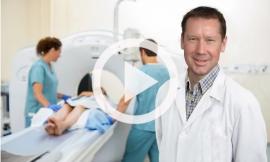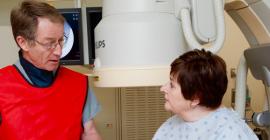Implementation of Canada’s only online BMD facility accreditation program begins accepting applications from hospitals and community-based clinics to ensure highest level of quality assurance, and the organisation of the first workstation BMD continuing medical education program for radiologists seeking training on the latest diagnostic interpretations for the diagnosis of osteoporosis in accordance with CAR guidelines.

OAR Accomplishments
OAR Patient Care Accomplishments
2015

2014

Integral involvement in the Ministry of Health’s multi-stakeholder expert panel to make recommendations about Ontario’s quality assurance and peer review framework for the delivery of diagnostic imaging services.
2013

The OAR was invited by Cancer Care Ontario and the College of Physicians and Surgeons of Ontario (CPSO) to develop a Quality Management Program overseeing the quality assurance and quality control aspects related to the delivery of mammography services across the province.
2012

Launched the OAR’s patient advocacy campaign to draw attention to the impact of government funding changes impacting Ontario patients’ access to diagnostic imaging services.
2011

Submission of the OAR’s Digital Mammography Report calling on the Ontario government to replace all x-ray film mammography equipment with state-of-the-art digital mammography equipment capable of detecting smaller cancers earlier, particularly for women with dense breast tissue.
2010

The OAR’s Canadian Bone Mineral Densitometry (CBMD) Program launched new BMD designation for Ontario’s Medical Radiation Technologists providing BMD services. The Accredited Densitometry Technologist (ADT) Designation was created following an announcement by the Canadian Society of Clinical Densitometry (CSCD) that it would no longer offer its BMD educational certification program.
2009

The OAR believed the cessation of the CSCD created a concerning gap for technologists interested in maintaining their BMD credentials. In response the OAR announced the ADT Program to fill the void by “grandfathering” any technologist with either a CSCD and/or ISCD designation into the new program. The OAR provided the ADT designation at no cost and developed a comprehensive educational program exam to enhance profession standing.
2008

Several reports were released by the OAR addressing the worsening wait list problem affecting millions of Ontario patients especially the long 12-18 month waits for an MRI scan and 8-12 months for a CT diagnosis. Other reports addressed growing wait times for common diagnostic examinations as well as the inequitable level of access to the same common exams essential for the diagnosis of cancer, neurological conditions, infectious disease, and cardiovascular issues.
2007

Creation of the Canadian Bone Mineral Densitometry (CBMD) Accreditation program in conjunction with Osteoporosis Canada on behalf of the Ontario Ministry of Health to provide a clinical peer reviewed program also involving medical physicists in the uniform technical performance of the diagnostic equipment for the improved detection of osteoporosis and bone loss in Ontario patients. CBMD was the first operating accreditation program in the world resulting in higher quality delivery and improved utilisation of these services. So far, one-third of Ontario’s 300 BMD scanners have been accredited by this OAR quality management program.

Launching of the OAR’s Continuing Medical Education program to facilitate the local delivery of high quality medical training and education for Ontario’s radiologists and imaging technologists. To date, well over 6,000 participants have attended these educational programs, many of which have been sold out. Attendees have been able to immediately apply new skills and current knowledge thereby providing Ontario patients with the best-trained radiologist and technologist workforce in Canada.

Approval of a total of $2.5 Billion of Federal government funding to address the outdated medical equipment crisis in Canada of which $950M was allocated to Ontario. Approximately half of that amount was invested in new radiology equipment and the initiation of a digital imaging environment in Ontario hospitals’ radiology departments and community-based imaging clinics.

Creation of the Dr. Harald Stolberg Radiology Excellence Fund to provide a bursary to a senior resident accepted to do fellowship training outside of Canada in an aspect of radiology training not currently offered in Ontario’s teaching program. The objective is to bring new diagnostic imaging skills back to the province following the completion of the newly trained radiologist’s fellowship.
2006

Called on the Ontario government to fund the digital conversion of Ontario clinics and hospitals from an x-ray film environment into a fully digital imaging system capable of improving patient care through the increased ability to transfer patient images between health care sites as well as to permit accelerated access for patients needing a diagnosis and treatment.

Launched a public education radio campaign to alert the public, government and media about the impact of radiology underfunding on patient wait lists and related issues.
2005

Preparation of the first report in Ontario identifying the $1 Billion out-dated diagnostic imaging equipment crisis in Ontario hospitals and clinics with a list of recommendations calling on the federal and Ontario governments to fund the immediate replacement of this equipment as well as to develop an on-going strategy for equipment replacement to benefit all Ontario patients. The report was key to influencing health decision-makers across Canada to investigate similar issues in other provinces.
2004

Unanimous approval of a resolution by Ontario radiologists that all Ontario hospitals and clinics providing mammography services be accredited by the Canadian Association of Radiologists’ Mammography Accreditation Program in order to ensure higher levels of quality assurance for Ontario patients.
1998

The development of the Magnetic Resonance Imaging (MRI) Business Case submission to the Ontario Ministry of Health recommending the introduction of MRI scanners into Ontario community hospitals based on demonstrated clinical needs and appropriate criteria. The OAR’s MRI Business Case was adopted by the Ontario Ministry of Health as the formal application process for MRI scanner service approvals as well as the adoption of training standards for radiologists delivering these services.
1995

The development of the Computed Tomography (CT) Business Case for the expansion of CT scanners into Ontario hospitals based on demonstrated clinical needs and appropriate criteria. The OAR CT Business Case was adopted by the Ontario Ministry of Health as the formal application process for CT scanner service approvals in Ontario hospitals.
1994

Creation of MICO Medical Imaging Clinics of Ontario to create the first group buying organization to enable the sustainability of Ontario radiology clinics and to safeguard the continuance of local outpatient access for common radiology examinations.
1993

Improvements to the delivery of the Ontario Breast Screening Program (OBSP) in order to facilitate the expanded involvement of Ontario mammography services in more Ontario hospitals and clinics.
1992

Formation of the Council of Medical Imaging to forge medical professional and diagnostic imaging industry concerns into public policy statements on patient safety and the introduction of advanced imaging technologies to diagnose disease at an earlier stage enabling better patient outcomes.
1991

Several OAR radiologists have chaired the College of Physician and Surgeons of Ontario’s Independent Health Facility Radiology Task Force since its inception in 1991. The IHF Radiology Taskforce is charged with developing quality assurance and quality control standards in Ontario’s radiology clinics to advise both the CPSO and the Ontario Ministry of Health and Long-Term Care.
1990

Creation of the OAR’s Independent Health Facility Quality Assurance Manual to ensure that the needs of Ontario patients was provided at the highest possible level in the province’s several hundred community-based radiology clinics.
1988

Re-launching of the Ontario Association of Radiologists to address on-going challenges and issues in the Ontario health care system that were increasingly impacting Ontario patients’ access to modern diagnostic imaging services.
1949

Creation of the Ontario Association of Radiologists to “promote the science of radiology and the knowledge of the members in connection with the practice of the profession of radiology.





